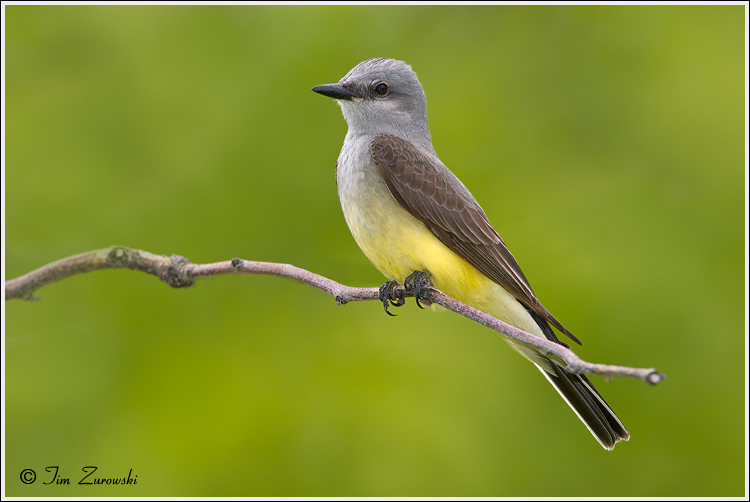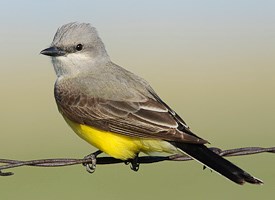
Tyrannus verticalis
SUBFAMILY
Tyranninae
TAXONOMY
Tyrannus verticalis T. Say, 1823, La Junta, Colorado. Monotypic.
OTHER COMMON NAMES
English: Arkansas kingbird; French: Tyran de l’Ouest; German:
Arkansastyrann; Spanish: Pitirre Occidental.
PHYSICAL CHARACTERISTICS
8.75 in (22 cm); 1.4 oz (40 g). Plumage includes pale ashy gray
head, neck, and breast, olive-green tinted back, bright lemonyellow
underparts, and dark brown wings. Tail is squared and
black with white outer edges. Feet and legs are black. Bill is
small, flat, and black. The crown, rarely erect, hides a red-orange
patch. Sexes are similar.
DISTRIBUTION
Occurs throughout the western half of the continental United
States, with limited extensions into western Canada and northern
Mexico. Winters in southwestern Mexico and Central
America. Vagrants are common during migration in the southeastern
United States.
HABITAT
Semiarid open areas and grasslands with scattered trees. During
the twentieth century, range expanded with the spread of
agriculture; buildings, utility structures, and fences provide new
foraging perches and nest sites. Lives gregariously in urban areas;
up to three pairs can nest in the same tree.
BEHAVIOR
Lives singly, in pairs, or in small groups. Male performs
courtship flight display, involving upward darting flight, fluttering
and vibrating of feathers, and trilling vocalizations. Regular
call is a quiet, quick “bek!” Also chatters abrasively:
“ker-er-ip, ker-er-ip, pree preee pr-prrr.” Known for being aggressively
territorial, often chasing large birds such as hawks,
crows, and ravens away from its nesting area.
FEEDING ECOLOGY AND DIET
Sallies from low, middle, and high perches in open areas to
catch insects in midair, returning to the same perch. Hovers
momentarily over prey before dipping to catch. Also takes
fruits and berries.
REPRODUCTIVE BIOLOGY
Monogamous breeders, in solitary pairs or in small colonies.
Nests are built by both sexes, near the trunk on a horizontal
limb or on a cross-arm of a human-made structure. Nest is
cup-shaped. Clutches of three to seven eggs are incubated 18
to 19 days by the female; and young are fed by both parents
and fledge after 16 to 17 days.
CONSERVATION STATUS
Not threatened.
SIGNIFICANCE TO HUMANS
Well-known locally.
Photo Gallery of - Western kingbird




 Animalia Life
Animalia Life